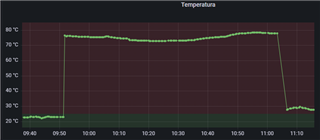I have worked for several months with the TMP117, while validating various equipment with the TMP117 IC, rarely it suddenly heats up, reaching approximately 80 °C, it stays in that state until re-energized.
I have not been able to replicate the problem on the same IC, occasionally it happens again on another IC (total of 3 different PCB designs, 2 custom and one SparkFun evaluation board). The sensor gets so hot that it can even hurt your finger if you touch it.
While it is with this heating problem, it is still operational, and you can read the temperature, as shown in the following picture of a dashboard of a system reading the temperature of the TMP117 and shutdown it, for 30 seconds, and so on continuously. From one measurement to the next one, it was already hot and only cooled down when the system was re-energized.

This failure has occurred very rarely in testing, but our final application must be reliable, and it could be catastrophic to have such a problem. On the other hand, there will be thousands of devices, which increases the chances of failure. Do you know why this happens? Can it be avoided?

